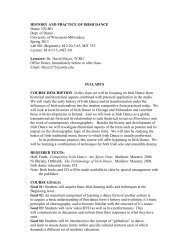Inside: - UW-Milwaukee
Inside: - UW-Milwaukee
Inside: - UW-Milwaukee
You also want an ePaper? Increase the reach of your titles
YUMPU automatically turns print PDFs into web optimized ePapers that Google loves.
Faculty Research<br />
Managing Intellectual Property as<br />
Discretionary Investment Opportunities<br />
Biopharmaceutical fi rms can achieve<br />
the greatest success by managing<br />
their intellectual property as<br />
dis cre tionary investment opportunities<br />
or real options, according to research<br />
being con ducted by Edward Levitas,<br />
Asso ciate Professor of Organiza tions and<br />
Strategic Management. Levitas is working<br />
on a stream of research related to fi rms’<br />
inven tive activities, particularly in the con -<br />
text of biotechnology-based pharmaceutical<br />
fi rms.<br />
Contrary to many popular opinions, a<br />
patent does not guarantee the owner/<br />
assignee a certain product or immediate<br />
cash fl ows. In fact, evidence suggests that<br />
about 90% of all patented technologies are<br />
never even transformed into marketable<br />
products.<br />
Rather, a patent only provides the owner<br />
with the right to exclude others from<br />
using the technology for a limited period.<br />
Upon patent granting, therefore, managers<br />
16 OUTLOOK<br />
Edward Levitas<br />
do not obtain immediate clearance to<br />
commercialize a technology, but only<br />
obtain exclusive options on ways in which<br />
to attempt to exploit the technology.<br />
Patents as Real Options<br />
Many academics and practitioners now<br />
accept the idea that a fi rm’s value can be<br />
“decomposed” into two basic components,<br />
says Levitas — the value of cash fl ows from<br />
its current operations and the value of<br />
discretionary investment opportunities, or<br />
options, embedded in the fi rm’s resources.<br />
These embedded options provide the<br />
fi rm with fl exibility to alter operations in<br />
the face of environmental change.<br />
For example, upon being granted a patent,<br />
the fi rm is essentially given a number of<br />
exclusive options — such as the ability to<br />
attempt to manufacture a product based<br />
on the underlying technology, the ability<br />
to license the technology to another<br />
entity, the ability to further develop the<br />
technology into something more<br />
potentially valuable, the right to defer<br />
decision on the technology, and even the<br />
right to abandon the technology.<br />
Important Implications for<br />
Management Practice<br />
The distinction between current cash fl ows<br />
and future options may seem pedestrian,<br />
says Levitas, but it does have important<br />
implications for management practice.<br />
Most investments suffer from a degree of<br />
irreversibility — such as building or<br />
expanding research facilities — or the<br />
inability to fully recover the investment if<br />
plans change — which could occur during<br />
the marketing or promotion of a new<br />
pharmaceutical product.<br />
When future conditions are highly<br />
uncer tain, Levitas’ research indicates<br />
that it is advisable to make a series of<br />
incremental investments, when feasible,<br />
rather than commit unconditionally at<br />
the outset to a project. Assuming that a<br />
project can be terminated after each<br />
stage, incremental investing allows the<br />
fi rm to avoid committing the whole cost<br />
of the project upfront, and permits the<br />
gathering of information over time to<br />
assess whether the next investment (and<br />
the entire project) remains feasible.<br />
In short, he says, incremental investing<br />
allows for the cultivation of options.<br />
Options and<br />
Biopharmaceuticals<br />
Within the biopharmaceutical industry,<br />
companies face a host of uncertainties<br />
during product development. A company<br />
may discover mid-stream that there are<br />
low probabilities that the technology will<br />
be safe and effective in humans. Or a<br />
therapeutically effective treatment may not<br />
meet the standards of societal acceptability.<br />
Given such uncertainties, Levitas says that<br />
managers of these organizations should<br />
pay careful attention to managing their<br />
fi rms’ portfolios of technology options.<br />
Mismanagement of these options, such as<br />
over-committing to a project in times of<br />
uncertainty, can have drastic consequences.<br />
For example, committing to the building<br />
of a pilot plant to manufacture a drug for<br />
FDA clinical trials before assessing the<br />
effi cacy of the drug in animal models, or<br />
before assessing the degree to which the<br />
drug will be socially accepted, subjects<br />
the company to considerable risk of<br />
investment loss.

















